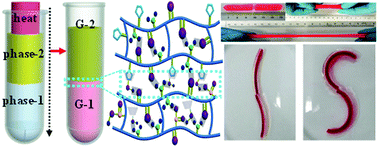Rapid preparation of auto-healing gels with actuating behaviour†
Abstract
Gels with multiple stimuli-responsive actuating behaviour have shown great potential in many applications. Nevertheless, facile approaches to rapidly preparing gel actuators are still highly needed, and obtaining gels possessing both actuating and auto-healing capabilities remains a challenge. Herein, we report the rapid preparation of gel actuators with a self-healing ability. Dual-component gels, composed of poly(BA-co-VI-co-AM) (G-1) and poly(BA-co-AA-co-AM/β-CD) (G-2) (BA = butyl acrylate, VI = N-vinyl imidazole, AM = acrylamide, AA = acrylic acid, β-CD = β-cyclodextrin), are prepared within 10 minutes (min) via biphase frontal polymerization (FP). Both G-1 and G-2 gels show excellent intrinsic self-healing properties based on hydrogen bonds, with healing efficiencies of 91% and 97%, respectively; self-healing between G-1 and G-2 also occurs due to hydrogen bonding and host–guest interactions. Moreover, dual-component gels, in terms of G-1 and G-2 bilayer gel flowers and strips, heterogeneous healed bilayer gel strips, and microfluidic-directed bilayer gel microsphere ensembles, all show actuating behaviour in acidic, alkaline and organic solutions, with actuation degrees up to 96% in 5 min. The actuation mechanism is also proposed. This work might provide new insights into fast synthesis of self-healing dual-component gels towards application in the actuator field.



 Please wait while we load your content...
Please wait while we load your content...